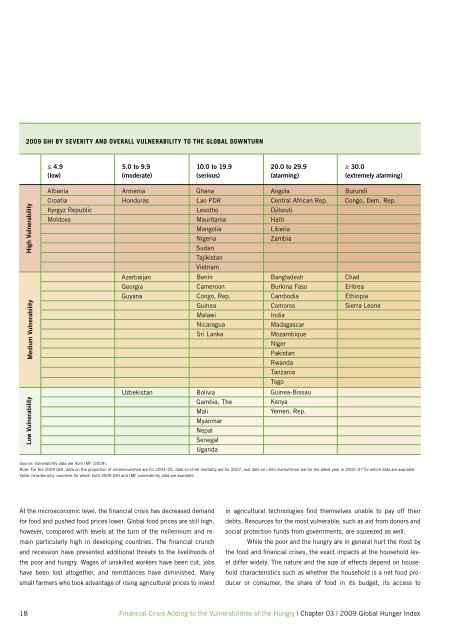2009 Global Hunger Index - International Food Policy Research ...
2009 Global Hunger Index - International Food Policy Research ...
2009 Global Hunger Index - International Food Policy Research ...
You also want an ePaper? Increase the reach of your titles
YUMPU automatically turns print PDFs into web optimized ePapers that Google loves.
<strong>2009</strong> GHI by severIty and overall vulnerabIlIty to tHe <strong>Global</strong> downturn<br />
High Vulnerability<br />
Low Vulnerability Medium Vulnerability<br />
≤ 4.9<br />
(low)<br />
Albania<br />
Croatia<br />
Kyrgyz Republic<br />
Moldova<br />
5.0 to 9.9<br />
(moderate)<br />
Armenia<br />
Honduras<br />
Azerbaijan<br />
Georgia<br />
Guyana<br />
Uzbekistan<br />
10.0 to 19.9<br />
(serious)<br />
Ghana<br />
Lao PDR<br />
Lesotho<br />
Mauritania<br />
Mongolia<br />
Nigeria<br />
Sudan<br />
Tajikistan<br />
Vietnam<br />
Benin<br />
Cameroon<br />
Congo, Rep.<br />
Guinea<br />
Malawi<br />
Nicaragua<br />
Sri Lanka<br />
Bolivia<br />
Gambia, The<br />
Mali<br />
Myanmar<br />
Nepal<br />
Senegal<br />
Uganda<br />
Source: Vulnerability data are from IMF (<strong>2009</strong>).<br />
Note: For the <strong>2009</strong> GHI, data on the proportion of undernourished are for 2003–05, data on child mortality are for 2007, and data on child malnutrition are for the latest year in 2002–07 for which data are available.<br />
Table includes only countries for which both <strong>2009</strong> GHI and IMF vulnerability data are available.<br />
At the microeconomic level, the financial crisis has decreased demand<br />
for food and pushed food prices lower. <strong>Global</strong> food prices are still high,<br />
however, compared with levels at the turn of the millennium and remain<br />
particularly high in developing countries. The financial crunch<br />
and recession have presented additional threats to the livelihoods of<br />
the poor and hungry. Wages of unskilled workers have been cut, jobs<br />
have been lost altogether, and remittances have diminished. Many<br />
small farmers who took advantage of rising agricultural prices to invest<br />
20.0 to 29.9<br />
(alarming)<br />
Angola<br />
Central African Rep.<br />
Djibouti<br />
Haiti<br />
Liberia<br />
Zambia<br />
Bangladesh<br />
Burkina Faso<br />
Cambodia<br />
Comoros<br />
India<br />
Madagascar<br />
Mozambique<br />
Niger<br />
Pakistan<br />
Rwanda<br />
Tanzania<br />
Togo<br />
Guinea-Bissau<br />
Kenya<br />
Yemen, Rep.<br />
≥ 30.0<br />
(extremely alarming)<br />
Burundi<br />
Congo, Dem. Rep.<br />
Chad<br />
Eritrea<br />
Ethiopia<br />
Sierra Leone<br />
in agricultural technologies find themselves unable to pay off their<br />
debts. Resources for the most vulnerable, such as aid from donors and<br />
social protection funds from governments, are squeezed as well.<br />
While the poor and the hungry are in general hurt the most by<br />
the food and financial crises, the exact impacts at the household level<br />
differ widely. The nature and the size of effects depend on household<br />
characteristics such as whether the household is a net food producer<br />
or consumer, the share of food in its budget, its access to<br />
18 Financial Crisis Adding to the Vulnerabilities of the Hungry | Chapter 03 | <strong>2009</strong> <strong>Global</strong> <strong>Hunger</strong> <strong>Index</strong>

















